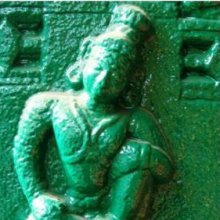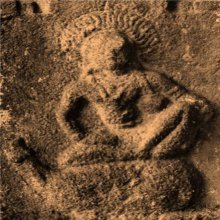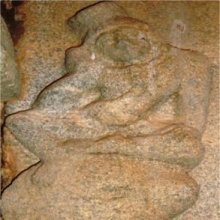Kurmanatha, Kūrmanātha, Kurma-natha: 8 definitions
Introduction:
Kurmanatha means something in Hinduism, Sanskrit. If you want to know the exact meaning, history, etymology or English translation of this term then check out the descriptions on this page. Add your comment or reference to a book if you want to contribute to this summary article.
Images (photo gallery)
In Hinduism
Shaivism (Shaiva philosophy)
Source: Wisdom Library: ŚaivismKūrmanātha (कूर्मनाथ) is an incarnation of Siddhanātha in the second yuga, belonging to the Pūrvāmnāya (‘eastern doctrine’) tradition of Kula Śaivism, according to the Ciñcinīmatasārasamuccaya. The consort of Kūrmanātha was Maṅgalājyotī and his two disciples are Ajita and Vijita. Siddhanātha incarnates as a Kaula master in each of the four yugas.
Source: Google Books: Manthanabhairavatantram (shaivism)Kūrmanātha (कूर्मनाथ) refers to one of the “four Lords (teachers) of the Ages” (Yuganātha).—Matsyendranātha is worshipped as the teacher of this Age along with three other teachers and their consorts who brought the Kaula Tantra into the world in the previous three Ages. These four Lords of the Ages (yuganātha) are highly revered in the Kālīkrama and came to be considered to be embodiments of the basic states of consciousness.
Consort of Kūrmanātha: According to the Kulakrīḍāvatāra-tantra: Maṅgalā; According to the Ciñcinīmatasārasamuccaya: Maṅgalājyoti; according to the Devīpañcaśatikā: Maṅgalāmbā.
Disciples of Kūrmanātha: According to the Kulakrīḍāvatāra-tantra: Jaitra and Ajita or Kullāīambā and Ānandamekhalā; According to the Ciñcinīmatasārasamuccaya: Ajita and Vijita.
Source: Nirvāṇa Sundarī: A Note on Kula and Kaula TantraKūrmanātha (कूर्मनाथ) is the name of the Kula-tantra Guru in the tretāyuga.—Abhinavagupta describes four Gurus for Kula Tantra based on the Yuga. Khagendranātha in satyayuga, Kūrmanātha in tretāyuga, Meṣanātha in dvāparayuga and Matsyendranātha for kaliyuga. During the Gurumaṇḍala Krama, one worships Khagendranātha and Vijjāmbā in East, Kūrmanātha and Maṅgalāmbā in the South, Meṣanātha and Kāmamaṅgalāmbā in West and Matsyendranātha and Koṅkaṇāmbā in the North.

Shaiva (शैव, śaiva) or Shaivism (śaivism) represents a tradition of Hinduism worshiping Shiva as the supreme being. Closely related to Shaktism, Shaiva literature includes a range of scriptures, including Tantras, while the root of this tradition may be traced back to the ancient Vedas.
Shilpashastra (iconography)
Source: DSpace at Pondicherry: Siddha Cult in Tamilnadu (sculpture)Kūrmanātha (कूर्मनाथ) refers to the first representation of the nine navanātha reliefs in the Ulsūr Someśvara temple.—The Kūrmanātha represents a Nātha seated on a on a tortoise. His right leg is folded resting on the tortoise. His right hand is resting on his right leg. He is folded and resting his left hand on his left leg knee. He is shown with rings on his both wrists, cross bands on his chest, wearing a loin cloth (laṅgoti) and kuṇḍalas on his ears.
In the Ulsūr Someśvara temple, on the south wall of the ardhamaṇḍapa, there found depictions of the navanāthas (eg. Kūrmanātha) in a variety of poses with huge coffiures, holding attributes such as kamaṇḍala, daṇḍa (staff) and so on. From east to west the nine sculptures of the Nāthas appear in the following order: seated respectively on a Tortoise, Vyāli, Lion, Fish, Scorpion, Snake, Antelope, Boar and Tiger.

Shilpashastra (शिल्पशास्त्र, śilpaśāstra) represents the ancient Indian science (shastra) of creative arts (shilpa) such as sculpture, iconography and painting. Closely related to Vastushastra (architecture), they often share the same literature.
Shaktism (Shakta philosophy)
Source: Google Books: ManthanabhairavatantramKūrmanātha (कूर्मनाथ) is the name of a Yuganātha (Lords of the ages), according to the Kularatnoddyota, one of the earliest Kubjikā Tantras.—The teachers [e.g., Kūrmanātha] and their consorts [e.g., Maṅgalāvvā] who brought the Kulāgama into the world in the four Ages [e.g., Treta] are related to the four sacred seats [e.g., Pūrṇagiri] in each of which grows a sacred tree [e.g., Bilva]. The text also lists the first disciples [e.g., Acintyavidhānanda (son)] of these teachers who then go on to have many more.

Shakta (शाक्त, śākta) or Shaktism (śāktism) represents a tradition of Hinduism where the Goddess (Devi) is revered and worshipped. Shakta literature includes a range of scriptures, including various Agamas and Tantras, although its roots may be traced back to the Vedas.
Languages of India and abroad
Sanskrit dictionary
Source: Cologne Digital Sanskrit Dictionaries: Monier-Williams Sanskrit-English DictionaryKūrmanātha (कूर्मनाथ):—[=kūrma-nātha] [from kūrma] m. Name of an author of Mantras.
[Sanskrit to German]
Sanskrit, also spelled संस्कृतम् (saṃskṛtam), is an ancient language of India commonly seen as the grandmother of the Indo-European language family (even English!). Closely allied with Prakrit and Pali, Sanskrit is more exhaustive in both grammar and terms and has the most extensive collection of literature in the world, greatly surpassing its sister-languages Greek and Latin.
See also (Relevant definitions)
Partial matches: Natha, Kurma.
Full-text (+8): Mangalajyoti, Ajita, Meshanatha, Khagendranatha, Acintyavidhananda, Kurma, Mangala, Mangalamba, Vijita, Jaitra, Kullaiamba, Anandamekhala, Matsyendranatha, Gutikanatha, Vindhyanatha, Alinatha, Varadeva, Citranatha, Amaranatha, Avarana.
Relevant text
Search found 2 books and stories containing Kurmanatha, Kūrmanātha, Kurma-natha, Kūrma-nātha; (plurals include: Kurmanathas, Kūrmanāthas, nathas, nāthas). You can also click to the full overview containing English textual excerpts. Below are direct links for the most relevant articles:
Chaitanya Bhagavata (by Bhumipati Dāsa)
Verse 1.9.197 < [Chapter 9 - Nityānanda’s Childhood Pastimes and Travels to Holy Places]
Varahi Tantra (English Study) (by Roberta Pamio)
Chapter 18 - The Āmnāyas (traditions), Continued < [Summary of the Vārāhī Tantra]


